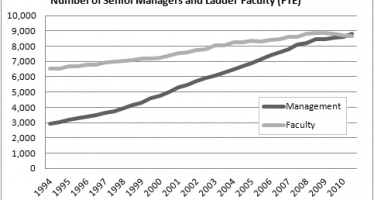Cal State’s Early Start Program sparks opposition
By Ariel Carmona Jr.
In recent years the California State University system has worked to jump-start many incoming freshmen through the controversial Early Start Program. But in the wake of the ESP, a number of educators across all CSU’s 23 campuses have expressed concerns over the restructuring of student remedial programs in the cash-strapped CSU system.
Thus far, the CSU Board of Trustees is steadfast in its implementation of the program, despite opposition and lingering questions about funding and about the impact it might have on low-income and disadvantaged students.
An ad hoc group calling itself the Access and Equity Workgroup, composed of more than 200 CSU faculty and staff representing all the campuses, addressed the CSU board of trustees earlier this year at the board’s headquarters in Long Beach.
The Early Start Program was enacted by outgoing CSU Chancellor Charles Reed via Executive Order 1048 in June 2010. The ESP creates a new 2012 mandate for CSU freshmen who have been given regular admission, but lack college-level proficiency in mathematics, English, or both.
Under the ESP, incoming freshmen needing assistance in math and/or English are required to enroll in remedial classes prior to the term they have been admitted — summer prior to fall. If students needing remediation do not participate in the program, with some exemptions, they will not be permitted to enroll at a CSU campus, barring extenuating circumstances.
“The goal is to help students not only complete remediation, but to be successful in all their courses. Fewer students who need to repeat courses because they have developed strong competencies will result in less cost to the system,” said CSU spokesperson Michael Uhlenkamp.
According to information made public by CSU, system-wide the bulk of entering first-time freshmen (60 percent) needed remedial courses. While at some CSU campuses, more than 75 percent needed remediation. The California Faculty Association reported that, in 2009, the level reached 93 percent at one campus, Dominguez Hills.
CSU Faculty and staff concerns about the ESP
Educators have said the ESP will disproportionally impact low-income students and students of color, many of whom must work during the summer to support their families and pay for their education costs.
CSU data of regularly admitted first-time CSU freshmen needing remediation in math and/or English reveal several things. Despite being academically CSU-eligible and in the top third of their high school class with an average GPA above 3.0, these students tend to come from high school districts with higher numbers of African-American and Latino students, greater poverty and fewer credentialed teachers. A greater number are English-language learners.
“Potentially students between high school and university education could have a job, could have family obligations and they could want to have a school-free summer before they start the very demanding project of going to college,” said Dorothy Wills, California Faculty Association president at Cal Poly Pomona. “Obviously there are an awful lot of entering students who do need remediation. So I guess the idea behind the executive order for Early Start was to beef it up even more to take some of the pressure off the English and Math departments. But offering the programs in summer and making them mandatory is perceived by most of us as being discriminatory.”
Cal Poly Pomona Associate Provost Claudia Pinter-Lucke refutes the assertion that participation in the program would be a hardship to students. “I would say that’s probably the weakest argument against Early Start,” she said, “The students can go to whatever campus they live closest to, so they don’t have the expense of long drives or airplane flights. A number of classes are offered online so students can do it from their homes, or they can do it after work if they need to work to raise funds for their expenses during the school year.”
Pinter-Lucke said there’s financial aid being offered by the chancellor’s office, which pays all fees associated with the program. In addition, each of the campuses has additional financial aid for which students can apply. Cal Poly has set up 1.5 unit classes designed to get students used to college expectations. “The whole point of these 1 unit classes was to give students a lower cost option than the full three semester unit or four unit quarter courses.”
Where is the funding coming from for Early Start Programs?
CSU confirmed the funding for Early Start is coming from the same funds already in place at each campus used to support all remedial programs. But neither Cal Poly Pomona nor Cal State Los Angeles administrators responded to questions regarding how much funding is already in place at each institution for remediation. Pinter-Lucke said virtually all work for the program is being done by current Cal Poly Pomona employees as part of their existing job duties and as part of the academic affairs department budget. So there has been no increase in expenses for the program.
“We’ve had it in our budget for seven years, so it really is a line item for us,” said Pinter-Lucke, adding that the only change has been that CSU has now made it a mandatory program.
The cost of the program to students is $182 per unit and it does not fluctuate at each campus. CSU does not agree with the contention that mandatory ESP classes place an financial burden on minority or low-income students, because financial aid is available to qualified students. Fee waivers are available to those who qualify for the entire cost of the program.
However, Uhlenkamp confirmed that some of the lottery funding given to CSU by the state is being diverted to provide financial aid for the ESP. And since lottery funds are state funds, that makes AB 540 students ineligible for the financial aid waiver to cover the program this summer. According to information made public on their website, CSU states that, as laws change in early 2013, AB 540 students may become eligible for ESP fee waivers, providing a mechanism is developed to estimate family support. “Overall, Early Start is largely expense-neutral in so far as students will finish their remediation requirements earlier.”
If it ain’t broke…
“There were several prototype programs throughout CSU before Early Start was adopted by all the campuses,” said Uhlenkamp. “As these programs were complementary, most of them continue side by side with Early Start.”
Pinter-Lucke said the number of admitted freshmen who needed remediation at Cal Poly Pomona had gone down from fall 2005 to fall 2010 (from 56 percent to 42 percent). And last fall, 93 percent gained full proficiency before their second year, versus 86 percent system wide. “I would think that is in part because of the emphasis we put on remediation in Early Start from the beginning,” Pinter-Lucke said. “You can see that they [CSU] felt that something needed to be done to improve the number of students who remediate after a year in college.”
“We have something like an 80 percent rate for those students to proceed into their academic programs and eventually graduate, so remediation when they take it on our campuses is effective,” said Wills. She added she does not understand why the Board of Trustees has gone ahead with Early Start, considering existing programs such as the Bridge Program and the Educational Opportunity Program are already in place.
“These are very good programs, and they perform the service of orienting students to university life, which is very important to these students,” Wills said. “The ones who are in the remedial classes and the ones who come for Bridge tend to be lower income students. Not at Cal Poly so much, but Dominguez Hills, East Bay. Not the more elite institutions. So does the ESP compete with EOP programs? In terms of student attention, student time and scheduling, if it does, that’s not a very good thing, because it further harms students who are already disadvantaged, educationally speaking. The motivation for it really escapes me.
“The CFA [California Faculty Association] does not approve of this program. Insufficient consultation was done. There seems to be a compelling motivation for handling it the way they are handling it. In the case of our campus, with the 1.5 credits it seems like a useless exercise in a very undemocratic handling of students, compelling them to take a little course. How is that going to help anybody? They are not going to be college ready after one unit of instruction.”
Hurdles
“There are always hurdles to overcome and adjustments with any new initiative,” said Uhlenkamp in response to assertions that the ESP will require substantial resources for design, implementation, and sustainability; and that it places differential burdens on individual campuses. “It is still early, but initial feedback from the rollout of Early Start points to the initiative being quite successful,” he said. Uhlenkamp adds evidence that programs such as the ESP are effective will be forthcoming when data from the system’s first experience is fully analyzed.
In terms of funding, the CSU was unable to provide overall figures of the system wide cost of implementing the program. “We don’t know, we’re still tallying the figures,” said Uhlenkamp, who added final results would mostly likely become available in November. He said CSU has allocated the same amount of funding the system would normally earmark toward remediation programs, but did not provide data what that amount might be. “The idea is, you don’t need to run as much remediation during the year because you’re starting in the summer.”
Others are not convinced of the program’s effectiveness. Nor do they approve of the way it has been implemented. The CSU English Council, comprised of members throughout all the CSU campuses, put out a position statement in opposition to the ESP in 2010 and again in fall 2011. It partly reads, “No valid evidence has been presented to us that Early Start is effective, and we do not feel students should be forced to enroll in programs whose educational value is unproven.” It goes on to cite a number of reasons why the council feels the program is both punitive and unnecessary.
Paul Browning, spokesperson with the Public Affairs Office at Cal State Los Angeles, said via e-mail that criticisms about the program are a bit premature. “I don’t believe anyone here at CSULA has formed opinions about these objections as of yet. At this point, we are just offering, running and monitoring the program,” he said.
However, Kimberly King, a psychology professor at Cal State L.A. and member of the Early Start Task Force, has been vocal in her opposition to the program. King went on Southern California public radio station KPCC in 2010 to express her views on the mandate, saying requirements which sounded easy to fill actually would not be. “We already have data based on our research that students from low-income backgrounds, and in particular African-American students, have a higher rate of incomplete applications,” King said at the time.
Since then, so far a total of eight resolutions against the mandatory program have been enacted by faculty, including by its English Council and campuses at Dominguez Hills, Los Angeles, Sacramento and San Luis Obispo. More such resolutions could be circulated in the near future.
Class staffing
One concern is the staffing of the classes. While professors are not required to be members of the faculty union to teach at the CSU level, Wills also cited concerns over the quality of instruction. “One version of how they were going to staff this had to do with brining community college teachers into the picture, which was obviously a problem with our faculty if it were supplanting them in the classroom,” Wills said. “We want university faculty to teach university students. Nothing against community college teachers, a lot of them teach as lecturers anyway. But we wanted to have something to say about who got hired to teach.”
Educators at various campuses said they wondered why counselors were not included in the system wide implementation of the program. “I don’t know if that’s the case, I don’t know who participated in all the conversations all the way through,” said Uhlenkamp.
In terms of staffing, Uhlenkamp said the hiring of teachers is all handled at the campus and departmental level and that in most cases it depends on the availability of faculty during summer at each individual campus.
Wills added that there remain lingering questions regarding instruction. “As the budget for remedial classes swells, it takes away from the instructional budget for more advanced instruction and more advanced courses,” Wills said. “So that those two departments, English and Math, are going to see a loss of lots of sections of Calculus and other advanced sections in math and a loss of sections in the English major. We need to divert more of the general fund to instruction and take it out of some of these shenanigans that the administration gets up to.”
Related Articles
Supreme Court ruling appears to help Vergara plaintiffs
A landmark U.S. Supreme Court decision last week that Texas programs implementing the federal Fair Housing Act have had a
How Gov. Brown could ace Napolitano on U.C. tuition
As Chris Reed noted last week, U.C. President Janet Napolitano has another thing coming if she thinks she can push a
Poll: Californians think higher ed is too expensive, love the quality
Californians are concerned over the cost of the state’s public colleges and universities, just as two of the state’s three





